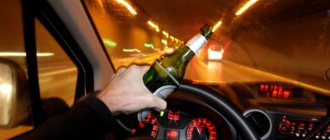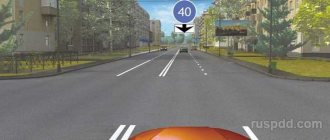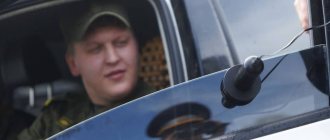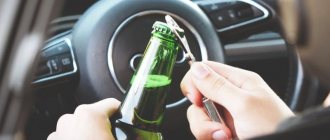What is ppm
This is the name of the indicator; in our case, the degree of alcohol intoxication of a person is established, and it will be calculated based on the amount of alcohol in the blood. If we count purely mathematically, then 1 ppm is equal to 0.45 mg per 1 liter. It is worth considering that alcoholic products remain in the blood for quite a long time, so special devices can accurately determine the presence of alcohol.
Now there are the following ways to determine it:
- the presence of alcohol is determined in the air exhaled by a person;
- The presence of alcohol in the blood is determined by taking a blood test from a vein in medical institutions.
How long does it take for alcohol to be detected when exhaled?
Let's look at the question of the duration of the concentration of alcohol vapor in the volume of air exhaled by the driver.
The time it takes for alcohol vapor to be removed from the body is influenced by factors such as individual ethanol tolerance, as well as many other factors:
- Citizen's gender.
- Age and weight.
- Number and type of drinks consumed.
- Chronic diseases of internal organs (liver, lungs, kidneys, heart).
It is known that ethanol is absorbed into the human body at different rates. For this reason, the duration of its content in the volume of exhaled air will differ significantly. Thus, in men, alcohol is eliminated from the body much faster than in women.
The withdrawal time is also affected by the volume of alcohol consumed and the factor of mixing different drinks. In addition, the duration of alcohol consumption largely depends on whether a person has chronic diseases. So, in people with a diseased liver, alcohol is eliminated for a very long time.
If a person drinks strong drinks for 2 days or longer (binge state), he will not be able to pass the breathalyzer and be allowed to drive a vehicle. In this case, the presence of alcohol in the blood, as well as the volume of exhaled air, is observed for about 72 hours.
And also the duration of the removal of ethyl from the volume of exhaled air is influenced by the amount of food eaten while drinking alcohol. If strong drinks were consumed without food, alcohol vapors are still detectable for quite some time. If a person has eaten and drank heavily, this process occurs much faster.
Table. Duration of elimination of alcohol vapors in the volume of exhaled air.
| Type of alcohol | Volume, ml | Duration of detection of ethanol in the air from the lungs, |
| Light beer | 500 | 40 min |
| Dry wine | 100 | 2,5-3 |
| Champagne | 100 | 1-1,5 |
| Vodka (40%) | 200 | 7-7,5 |
| Cognac | 100 | 4-4,5 |
Permissible alcohol limit while driving in ppm
Of course, the inspector will not check you for alcohol if there are no certain signs of intoxication and the person is in normal condition. The law requires you to undergo an examination if you have the following symptoms:
- slurred and incoherent speech of the driver;
- unnaturally reddened skin on a person’s face;
- unsteady gait and unnatural posture;
- characteristic smell of alcoholic drinks;
- unstable psychological and emotional state.
All of these symptoms usually appear after drinking alcoholic beverages. If there are characteristic signs, the inspector must draw up an inspection report and send the driver for a medical check.
On-site measurements of ppm are made with a breathalyzer in the exhaled air. Such measurements must take place in the presence of witnesses and the result of the inspection is reflected in the report. In the document, the inspector describes all identified signs of intoxication, information about all persons present during the measurement (full name, address, contact phone number), the amount of intoxication in ppm, as well as the date and time of detection of the violation of the law.
In the event that the driver refuses to undergo the examination or the device shows zero values, he is sent to a medical facility to re-measure the amount of alcohol in the person’s blood, but using a blood test. If you refuse the study, you will definitely be deprived of your right to drive a car for driving while drunk.
In 2021, the permissible standard has not changed compared to last year; it is equal to 0.16 ppm. Therefore, if the device detects a larger number, an administrative violation report will be drawn up against the driver.
It is worth remembering that there are a lot of products, the consumption of which can show a small amount of alcohol on a traffic inspector’s device:
- nonalcoholic beer;
- chocolate candies;
- kefir and other sourdough products;
- kvass;
- sandwich made from black bread and sausage, etc.
Each of these products contains a certain amount of alcohol, which is excreted only after some time. For several years (from 2010 to 2013), this led not only to financial sanctions, but also to the deprivation of the rights of many inexperienced drivers. After many trials, it was decided to abolish the zero ppm and establish a new standard - 0.16 ppm.
In 2021, a certain amendment to the law was adopted; if the driver is unable to exhale into a breathalyzer, for example, in the case of severe intoxication or unconsciousness, then in this case it is possible to take a blood test of the person and determine the degree of his intoxication. If the indicator is higher than 0.35 ppm, then, of course, the offender will not be able to avoid punishment. There is no need to specifically use both methods.
How to determine the approximate ppm level yourself
We have looked at the permissible alcohol standards for drivers; it is also worth paying attention to the existing values and features of their testing. Numerous studies have provided evidence for several facts from the table:
From this we can conclude that these values cannot be the result of errors in the measuring device and indicate a clear state of intoxication. The law conditionally stipulates a threshold value, according to which the driver is clearly recognized as drunk and does not have the opportunity to challenge the information from the protocol. This is 0.35 ppm in exhaled air.
Punishment for exceeding the permissible alcohol limit while driving
The law established fairly severe penalties for such violations, because a drunk driver is one of the main causes of car accidents, including deaths. That's why legislators are trying to tighten the penalties for driving while intoxicated.
Let's look at what the offender faces:
- upon initial detection, a fine of 30 thousand rubles may be imposed. and deprivation of the right to drive a car for 1.5-2 years;
- if a citizen repeatedly drives a car while drunk, the amount of the sanction increases to 50 thousand rubles, and the driving license will be taken away for 3 years;
- if a driver who has already been fined and deprived of his license is caught drunk driving a car, then he will be arrested for 10-15 days, these days he will have to sit behind bars;
- if the driver refuses to undergo a medical examination, then the measure will be applied to him, as in the first case.
Note!
If a car owner has transferred control of his vehicle to a person who is intoxicated, he faces liability equal to that if he himself was drunk driving: a 30 thousand fine and deprivation of rights from 1.5 to 2 years. The driver will receive the same punishment.
Many deputies are initiating the imposition of a more severe penalty and demand that administrative liability be replaced with criminal liability. Therefore, you should not break the established rules.
The traffic police offers a 50% discount if the fine is paid on time, but this opportunity does not apply in all cases; this privilege cannot be used if:
- the driver refused to undergo medical examination. examination;
- a person was caught driving a car while intoxicated.
Therefore, in these cases it will not be possible to reduce the fine.
Number of road accidents in Russia, comparison by year
As we can see from the statistics reflected in the table, since 2015 there has been an increase in “drunk” accidents in the country. In this regard, there is a need to adopt new legislative decisions aimed at combating drivers who drive while intoxicated. Russian laws provide for liability for drunk driving. In 2021, the punishment is under articles:
- 12.8 and 12.26 Code of Administrative Offenses of the Russian Federation;
- 264 and 264.1 of the Criminal Code of the Russian Federation.
On July 1, 2015, new stricter legislation was adopted. For repeated driving while intoxicated or repeated refusal to undergo a medical examination, the driver faces:
- the punishment is not administrative, as it was before, but according to the criminal code;
- a fine of 200 thousand to 300 thousand rubles, or up to 480 hours of compulsory labor, or 2 years of forced labor;
- imprisonment from two to nine years if people died in an accident;
- deprivation of driver's license for three years.
However, even the threat of going to jail does not stop drunkards from committing criminal acts, getting behind the wheel and endangering all those who happened to be next to him at that moment.
In this regard, in order to save us - innocent road users who may be harmed by a drunk driver on the roads, new measures were once again taken in 2021.
Punishment under the Criminal Code for exceeding the permissible alcohol limit while driving
This violation falls under the category of administrative cases, but in some cases criminal liability arises. Therefore, intoxication will be an aggravating circumstance in the following cases:
- An accident involving victims with serious injuries, when a drunk driver was the culprit of the accident. In this case, the penalty is imprisonment for up to 4 years;
- in case of a fatal accident, a prison sentence of no more than 7 years is imposed;
- if there are 2 deaths, you can end up behind bars for up to 9 years.
Note!
In case of criminal punishment, in addition to imprisonment, a person will be prohibited from driving for 3 years. Drivers often get off with suspended sentences.
Recommendations for drivers to avoid losing their driver's license
If you drank alcohol and for some reason had to get behind the wheel, but you don’t want trouble on the road, then you should follow the rules as much as possible:
- the best option is not to drive, but if there is no other choice, then it will be better if as much time as possible passes between drinking alcohol and driving;
- do not take medications, especially those containing ethyl alcohol;
- do not consume kvass and fermented milk products, as they can increase the amount of alcohol in the blood;
- the use of chewing gum may be regarded by the inspector as an attempt to hide traces of alcohol;
- Do not enter into conflict with the inspector under any circumstances, this will only aggravate the situation.
How is blood alcohol content determined?
A very important note - the blood alcohol content, unlike the usual “purge”, cannot be carried out on the road. That is, the traffic police inspector is obliged to send the driver for examination. Meanwhile, here lies a significant nuance in the procedural procedure for checking alcohol in a driver’s blood.
The point is that there is:
- examination for the state of alcohol intoxication, which is carried out on the road (“purging” into the device - OSAO),
- medical examination - carried out only in a medical institution (MOSO).
And there are specific reasons for sending the driver for a medical examination. Almost all of these grounds require a preliminary examination for alcohol intoxication:
- driver's refusal to use MTPL ("purge" on the road),
- if the driver does not agree with the results of the MTPL,
- if the inspector does not agree with the indicators of the insurance company,
- in case of an accident with victims.
It turns out that in order to take a driver’s blood for alcohol to determine the dose above 0.3 grams per liter, if this is not required after an accident with victims, it is necessary to “blow it out”. Because it is impossible to determine alcohol in the blood on the road - only in a medical facility. And for this there must be a referral for a medical examination.
Something else useful for you:
- The new law on the nullification of traffic police fines - is it true or not?
- What are the fines for driving without paying on a toll road? New law on non-payment of toll sections
- New traffic police fines and amendments to laws from February 1 and 20 - is this true or not?
Summary
The driver will not be able to deceive the modern devices of traffic police inspectors. Therefore, you should not exhale a little or, conversely, inhale air; in any case, the breathalyzer gives true readings. If a deviation from acceptable indicators is detected, a protocol on an administrative offense will be drawn up against a citizen.
Not only traffic safety on the road, but also human lives depend on the condition of the driver behind the wheel. Therefore, the best option, if you have drunk alcohol, is to ask a sober person to take you home or use public transport so as not to endanger yourself and others.
ATTENTION!
Due to recent changes in legislation, the information in this article may be out of date!
Our lawyer will advise you free of charge - write in the form below.
Why all these amendments?
Logical question. After all, everything was smooth and even before this - drunkards were caught and the presence of alcohol in the body was quite reliably determined! But it is not so. Not everyone was caught and not always. And the point here is in two significant differences in the definition of alcohol in the blood and exhalation.
- The good intention of legislators to deprive people of their rights for being intoxicated is for road safety: a driver in a state of intoxication has dulled attention and takes longer to react - these are proven facts. And attention and reaction are controlled by the brain, which circulates blood. And it is the blood alcohol content that determines a more reliably drunken state.
- The second subtlety lies in the very legislative definition of the procedure - more precisely, one case of testing intoxication. If a person is unconscious or dead/died, then it is impossible to determine the presence of alcohol in his exhalation. Meanwhile, according to the rules, it must be examined (after an accident). But it would have been impossible to punish him based on the results of a blood test without the new law - after all, according to the old law, deprivation with a fine was imposed only if the concentration of alcohol in the exhale was above 0.16 mg/liter. Now, based on the results of determining blood alcohol level of more than 0.3 g/liter, a person will be deprived of his rights if he or she regains consciousness, of course.
By the way, the “limits” for alcohol content in our country still remain quite strict - almost 2 times stricter than the permissible limits. The Vienna Convention agreement (all countries that have adopted it are obliged to develop legislation in accordance with its provisions) implies the following restrictions on the alcohol content in the body when driving a car:
- 0.5 grams of alcohol per liter of blood,
- 0.25 milligrams of alcohol per liter in exhaled air.
And finally, some statistics on accidents with drunk drivers for January and February 2021 according to the traffic police:










